WoW64 - aka Windows (32-bit) on Windows (64-bit) - is a subsystem that enables 32-bit Windows applications to run on 64-bit Windows. Most people today are familiar with WoW64 on Windows x64, where they can run x86 applications. WoW64 has been with us since Windows XP, and x64 wasn’t the only architecture where WoW64 has been available - it was available on IA-64 architecture as well, where WoW64 has been responsible for emulating x86. Newly, WoW64 is also available on ARM64, enabling emulation of both x86 and ARM32 appllications.
MSDN offers brief article on WoW64 implementation details. We can find that WoW64 consists of (ignoring IA-64):
- Translation support DLLs:
wow64.dll: translation ofNt*system calls (ntoskrnl.exe/ntdll.dll)wow64win.dll: translation ofNtGdi*,NtUser*and other GUI-related system calls (win32k.sys/win32u.dll)
- Emulation support DLLs:
wow64cpu.dll: support for running x86 programs on x64wowarmhw.dll: support for running ARM32 programs on ARM64xtajit.dll: support for running x86 programs on ARM64
Besides Nt* system call translation, the wow64.dll provides the core
emulation infrastructure.
If you have previous experience with reversing WoW64 on x64, you can notice
that it shares plenty of common code with WoW64 subsystem on ARM64. Especially
if you peeked into WoW64 of recent x64 Windows, you may have noticed that it
actually contains strings such as SysArm32 and that some functions check
against IMAGE_FILE_MACHINE_ARMNT (0x1C4) machine type:
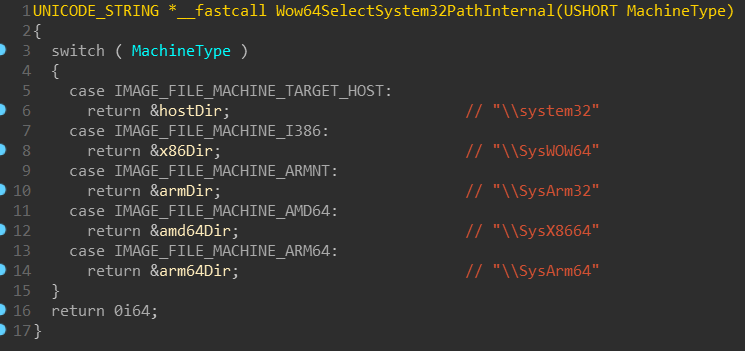

WoW on x64 systems cannot emulate ARM32 though - it just apparently shares
common code. But SysX8664 and SysArm64 sound particularly interesting!
Those similarities can help anyone who is fluent in x86/x64, but not that much in ARM. Also, HexRays decompiler produce much better output for x86/x64 than for ARM32/ARM64.
Initially, my purpose with this blogpost was to get you familiar with how WoW64 works for ARM32 programs on ARM64. But because WoW64 itself changed a lot with Windows 10, and because WoW64 shares some similarities between x64 and ARM64, I decided to briefly get you through how WoW64 works in general.
Everything presented in this article is based on Windows 10 - insider preview, build 18247.
Table of contents
Terms
Througout this article I’ll be using some terms I’d like to explain beforehand:
ntdllorntdll.dll- these will be always refering to the nativentdll.dll(x64 on Windows x64, ARM64 on Windows ARM64, …), until said otherwise or until the context wouldn’t indicate otherwise.ntdll32orntdll32.dll- to make an easy distinction between native and WoW64ntdll.dll, any WoW64ntdll.dllwill be refered with the*32suffix.emuoremu.dll- these will represent any of the emulation support DLLs (one ofwow64cpu.dll,wowarmhw.dll,xtajit.dll)module!FunctionName- refers to a symbolFunctionNamewithin themodule. If you’re familiar with WinDbg, you’re already familiar with this notation.CHPE- “compiled-hybrid-PE”, a new type of PE file, which looks as if it was x86 PE file, but has ARM64 code within them.CHPEwill be tackled in more detail in the x86 on ARM64 section.- The terms emulation and binary-translation refer to the WoW64 workings and they may be used interchangeably.
Kernel
This section shows some points of interest in the ntoskrnl.exe regarding to
the WoW64 initialization. If you’re interested only in the user-mode part of
the WoW64, you can skip this part to the
Initialization of the WoW64 process.
Kernel (initialization)
Initalization of WoW64 begins with the initialization of the kernel:
nt!KiSystemStartupnt!KiInitializeKernelnt!InitBootProcessornt!PspInitPhase0nt!Phase1Initializationnt!IoInitSystemnt!IoInitSystemPreDriversnt!PsLocateSystemDlls
nt!PsLocateSystemDlls routine takes a pointer named nt!PspSystemDlls,
and then calls nt!PspLocateSystemDll in a loop. Let’s figure out what’s
going on here:


nt!PspSystemDlls appears to be array of pointers to some structure, which
holds some NTDLL-related data. The order of these NTDLLs corresponds with
this enum (included in the PDB):
Now, let’s look how such structure looks like:
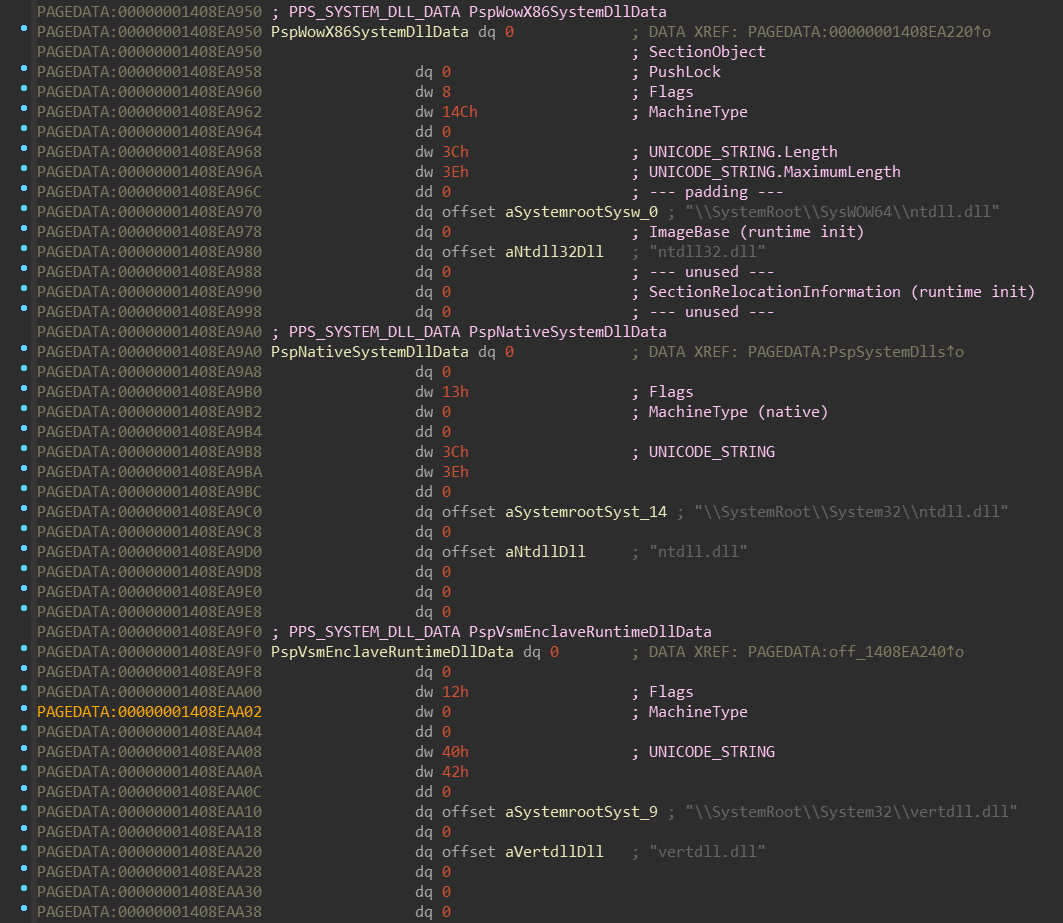
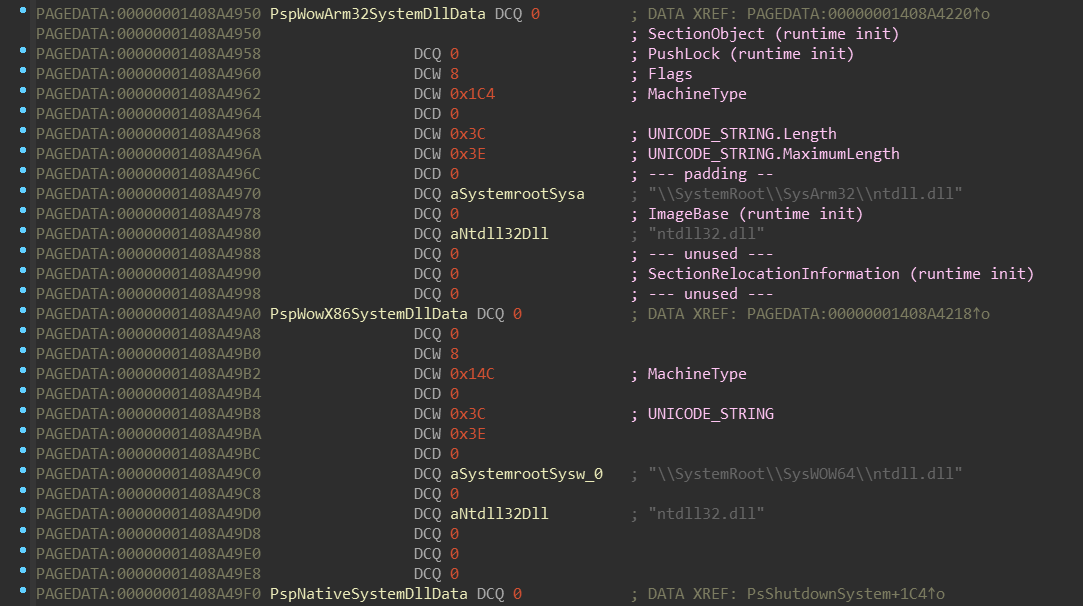
The nt!PspLocateSystemDll function intializes fields of this structure. The
layout of this structure isn’t unfortunatelly in the PDB, but you can
find a reconstructed version in the appendix.
Now let’s get back to the nt!Phase1Initialization - there’s more:
...nt!Phase1Initializationnt!Phase1InitializationIoReadynt!PspInitPhase2nt!PspInitializeSystemDlls
nt!PspInitializeSystemDlls routine takes a pointer named nt!NtdllExportInformation.
Let’s look at it:


It looks like it’s some sort of array, again, ordered by the enum _SYSTEM_DLL_TYPE.
Let’s examine NtdllExports:
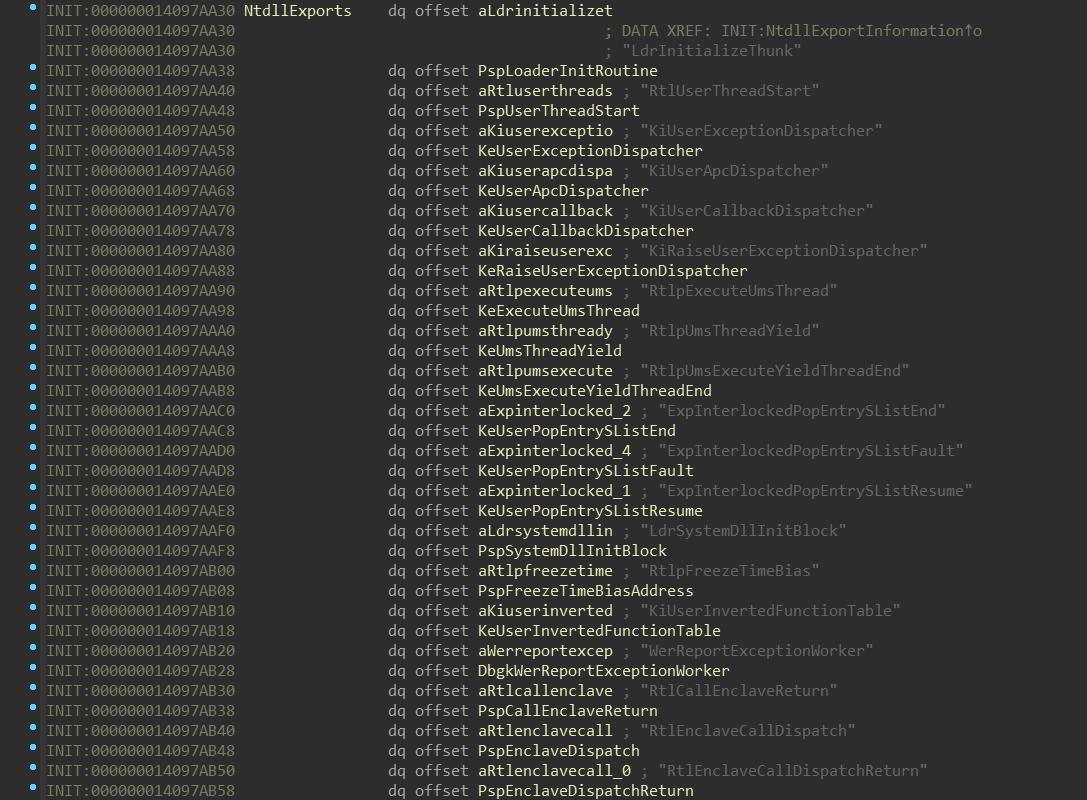
Nothing unexpected - just tuples of function name and function pointer.
Did you notice the difference in the number after the NtdllExports field? On x64
there is 19 meanwhile on ARM64 there is 14. This number represents number
of items in NtdllExports - and indeed, there is slightly different set of them:
| x64 | ARM64 |
|---|---|
(0) LdrInitializeThunk |
(0) LdrInitializeThunk |
(1) RtlUserThreadStart |
(1) RtlUserThreadStart |
(2) KiUserExceptionDispatcher |
(2) KiUserExceptionDispatcher |
(3) KiUserApcDispatcher |
(3) KiUserApcDispatcher |
(4) KiUserCallbackDispatcher |
(4) KiUserCallbackDispatcher |
| - | (5) KiUserCallbackDispatcherReturn |
(5) KiRaiseUserExceptionDispatcher |
(6) KiRaiseUserExceptionDispatcher |
(6) RtlpExecuteUmsThread |
- |
(7) RtlpUmsThreadYield |
- |
(8) RtlpUmsExecuteYieldThreadEnd |
- |
(9) ExpInterlockedPopEntrySListEnd |
(7) ExpInterlockedPopEntrySListEnd |
(10) ExpInterlockedPopEntrySListFault |
(8) ExpInterlockedPopEntrySListFault |
(11) ExpInterlockedPopEntrySListResume |
(9) ExpInterlockedPopEntrySListResume |
(12) LdrSystemDllInitBlock |
(10) LdrSystemDllInitBlock |
(13) RtlpFreezeTimeBias |
(11) RtlpFreezeTimeBias |
(14) KiUserInvertedFunctionTable |
(12) KiUserInvertedFunctionTable |
(15) WerReportExceptionWorker |
(13) WerReportExceptionWorker |
(16) RtlCallEnclaveReturn |
- |
(17) RtlEnclaveCallDispatch |
- |
(18) RtlEnclaveCallDispatchReturn |
- |
We can see that ARM64 is missing Ums (User-Mode Scheduling) and
Enclave functions. Also, we can see that ARM64 has one
extra function: KiUserCallbackDispatcherReturn.
On the other hand, all NtdllWow*Exports contain the same set of function names:
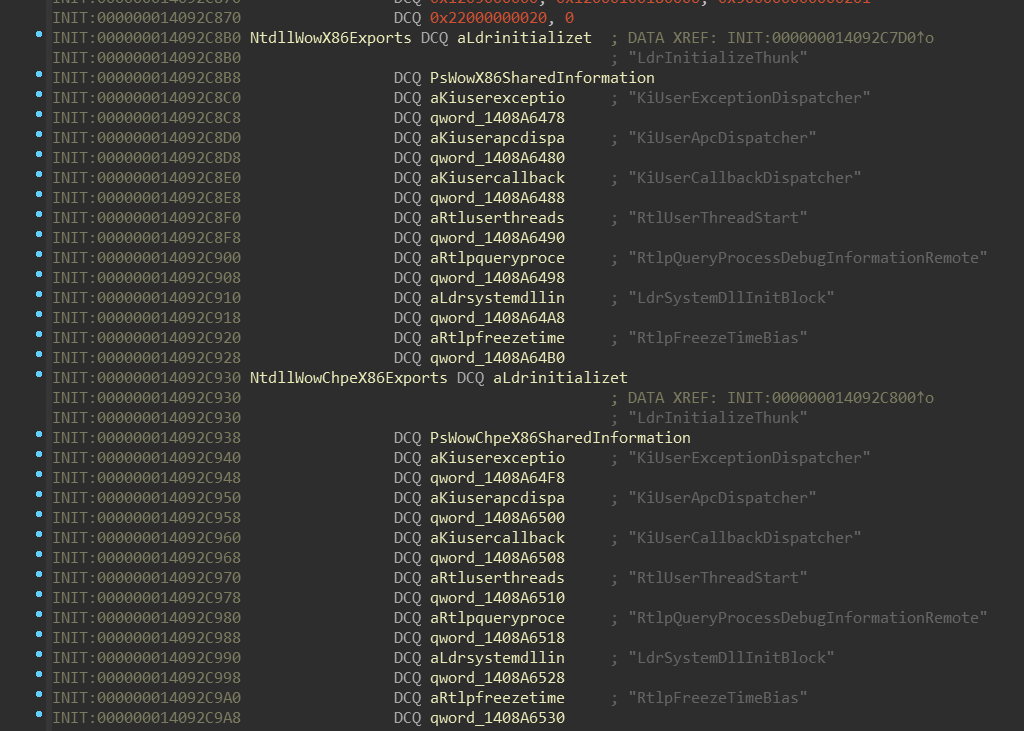
Notice names of second fields of these “structures”: PsWowX86SharedInformation,
PsWowChpeX86SharedInformation, … If we look at the address of those fields,
we can see that they’re part of another array:

Those addresses are actually targets of the pointers in the NtdllWow*Exports
structure. Also, those functions combined with PsWow*SharedInformation might
give you hint that they’re related to this enum (included in the PDB):
Notice how the order of the SharedNtdll32BaseAddress corellates with the empty field in
the previous screenshot (highlighted). The set of WoW64 NTDLL functions is same
on both x64 and ARM64.
(The C representation of this data can be found in the appendix.)
Now we can tell what the nt!PspInitializeSystemDlls function does - it gets
image base of each NTDLL (nt!PsQuerySystemDllInfo), resolves all
Ntdll*Exports for them (nt!RtlFindExportedRoutineByName). Also, only for
all WoW64 NTDLLs (if ((SYSTEM_DLL_TYPE)SystemDllType > PsNativeSystemDll))
it assigns the image base to the SharedNtdll32BaseAddress field of the
PsWow*SharedInformation array (nt!PspWow64GetSharedInformation).
Kernel (create process)
Let’s talk briefly about process creation. As you probably already know, the
native ntdll.dll is mapped as a first DLL into each created process. This
applies for all architectures - x86, x64 and also for ARM64.
The WoW64 processes aren’t exception to this rule - the WoW64 processes share
the same initialization code path as native processes.
nt!NtCreateUserProcessnt!PspAllocateProcessnt!PspSetupUserProcessAddressSpacent!PspPrepareSystemDllInitBlocknt!PspWow64SetupUserProcessAddressSpace
nt!PspAllocateThreadnt!PspWow64InitThreadnt!KeInitThread // Entry-point: nt!PspUserThreadStartup
nt!PspUserThreadStartupnt!PspInitializeThunkContextnt!KiDispatchException
If you ever wondered how is the first user-mode instruction of the newly created
process executed, now you know the answer - a “synthetic” user-mode exception
is dispatched, with ExceptionRecord.ExceptionAddress = &PspLoaderInitRoutine,
where PspLoaderInitRoutine points to the ntdll!LdrInitializeThunk.
This is the first function that is executed in every process - including WoW64
processes.
Initialization of the WoW64 process
The fun part begins!
NOTE: Initialization of the
wow64.dllis same on both x64 and ARM64. Eventual differences will be mentioned.
ntdll!LdrInitializeThunkntdll!LdrpInitializentdll!_LdrpInitializentdll!LdrpInitializeProcessntdll!LdrpLoadWow64
The ntdll!LdrpLoadWow64 function is called when the ntdll!UseWOW64 global variable is TRUE,
which is set when NtCurrentTeb()->WowTebOffset != NULL.
It constructs the full path to the wow64.dll, loads it, and then resolves
following functions:
Wow64LdrpInitializeWow64PrepareForExceptionWow64ApcRoutineWow64PrepareForDebuggerAttachWow64SuspendLocalThread
NOTE: The resolution of these pointers is wrapped between pair of
ntdll!LdrProtectMrdatacalls, responsible for protecting (1) and unprotecting (0) the.mrdatasection - in which these pointers reside.MRDATA(Mutable Read Only Data) are part of the CFG (Control-Flow Guard) functionality. You can look at Alex’s slides for more information.
When these functions are successfully located, the ntdll.dll finally
transfers control to the wow64.dll by calling wow64!Wow64LdrpInitialize.
Let’s go through the sequence of calls that eventually bring us to the entry-point
of the “emulated” application.
wow64!Wow64LdrpInitializewow64!Wow64InfoPtr = (NtCurrentPeb32() + 1)NtCurrentTeb()->TlsSlots[/* 10 */ WOW64_TLS_WOW64INFO] = wow64!Wow64InfoPtrntdll!RtlWow64GetCpuAreaInfowow64!ProcessInitwow64!CpuNotifyMapViewOfSection // Process imagewow64!Wow64DetectMachineTypeInternalwow64!Wow64SelectSystem32PathInternalwow64!CpuNotifyMapViewOfSection // 32-bit NTDLL imagewow64!ThreadInitwow64!ThunkStartupContext64TO32wow64!Wow64SetupInitialCallwow64!RunCpuSimulationemu!BTCpuSimulate
Wow64InfoPtr is the first initialized variable in the wow64.dll. It contains
data shared between 32-bit and 64-bit execution mode and its structure is not
documented, although you can find this structure partialy restored in the appendix.
RtlWow64GetCpuAreaInfo is an internal ntdll.dll function which is called a lot
during emulation. It is mainly used for fetching the machine type and architecture-specific
CPU context (the CONTEXT structure) of the emulated process. This information is fetched into an undocumented
structure, which we’ll be calling WOW64_CPU_AREA_INFO. Pointer to this structure
is then given to the ProcessInit function.
Wow64DetectMachineTypeInternal determines the machine type of the executed
process and returns it. Wow64SelectSystem32PathInternal selects the “emulated”
System32 directory based on that machine type, e.g. SysWOW64 for x86 processes
or SysArm32 for ARM32 processes.
You can also notice calls to CpuNotifyMapViewOfSection function. As the name
suggests, it is also called on each “emulated” call of NtMapViewOfSection.
This function:
- Checks if the mapped image is executable
- Checks if following conditions are true:
NtHeaders->OptionalHeader.MajorSubsystemVersion == USER_SHARED_DATA.NtMajorVersionNtHeaders->OptionalHeader.MinorSubsystemVersion == USER_SHARED_DATA.NtMinorVersion
If these checks pass, CpupResolveReverseImports function is called. This function
checks if the mapped image exports the Wow64Transition symbol and if so, it
assigns there a 32-bit pointer value returned by emu!BTCpuGetBopCode.
The Wow64Transition is mostly known to be exported by SysWOW64\ntdll.dll,
but there are actually multiple of Windows’ WoW DLLs which exports this symbol.
You might be already familiar with the term “Heaven’s Gate” -
this is where the Wow64Transition will point to on Windows x64 - a simple far
jump instruction which switches into long-mode (64-bit) enabled code segment.
On ARM64, the Wow64Transition points to a “nop” function.
NOTE: Because there are no checks on the
ImageName, theWow64Transitionsymbol is resolved for all executable images that passes the checks mentioned earlier. If you’re wondering whetherWow64Transitionwould be resolved for your custom executable or DLL - it indeed would!
The initialization then continues with thread-specific initialization by
calling ThreadInit. This is followed by pair of calls
ThunkStartupContext64TO32(CpuArea.MachineType, CpuArea.Context, NativeContext)
and Wow64SetupInitialCall(&CpuArea) - these functions perform the necessary
setup of the architecture-specific WoW64 CONTEXT structure to prepare start
of the execution in the emulated environment. This is done in the exact same
way as if ntoskrnl.exe would actually executed the emulated application - i.e.:
- setting the instruction pointer to the address of
ntdll32!LdrInitializeThunk - setting the stack pointer below the WoW64
CONTEXTstructure - setting the 1st parameter to point to that
CONTEXTstructure - setting the 2nd parameter to point to the base address of the
ntdll32
Finally, the RunCpuSimulation function is called. This function just
calls BTCpuSimulate from the binary-translator DLL, which contains the
actual emulation loop that never returns.
wow64!ProcessInit
wow64!Wow64ProtectMrdata // 0wow64!Wow64pLoadLogDllntdll!LdrLoadDll // "%SystemRoot%\system32\wow64log.dll"
wow64.dll has also it’s own .mrdata section and ProcessInit begins with
unprotecting it. It then tries to load the wow64log.dll from the constructed
system directory. Note that this DLL is never present in any released Windows
installation (it’s probably used internally by Microsoft for debugging of the
WoW64 subsystem). Therefore, load of this DLL will normally fail. This isn’t
problem, though, because no critical functionality of the WoW64 subsystem
depends on it. If the load would actually succeed, the wow64.dll would try
to find following exported functions there:
Wow64LogInitializeWow64LogSystemServiceWow64LogMessageArgListWow64LogTerminate
If any of these functions wouldn’t be exported, the DLL would be immediately unloaded.
If we’d drop custom wow64log.dll (which would export functions mentioned above)
into the %SystemRoot%\System32 directory, it would actually get loaded into
every WoW64 process. This way we could drop a custom logging DLL, or even inject
every WoW64 process with native DLL!
For more details, you can check my injdrv project which implements injection of native DLLs into WoW64 processes, or check this post by Walied Assar.
Then, certain important values are fetched from the LdrSystemDllInitBlock array.
These contains base address of the ntdll32.dll, pointer to functions like
ntdll32!KiUserExceptionDispatcher, ntdll32!KiUserApcDispatcher, …,
control flow guard information and others.
Finally, the Wow64pInitializeFilePathRedirection is called, which - as the name
suggests - initializes WoW64 path redirection. The path redirection is completely
implemented in the wow64.dll and the mechanism is basically based on string
replacement. The path redirection can be disabled and enabled by calling
kernel32!Wow64DisableWow64FsRedirection & kernel32!Wow64RevertWow64FsRedirection
function pairs. Both of these functions internally call ntdll32!RtlWow64EnableFsRedirectionEx,
which directly operates on NtCurrentTeb()->TlsSlots[/* 8 */ WOW64_TLS_FILESYSREDIR] field.
wow64!ServiceTables
Next, a ServiceTables array is initialized. You might be already familiar
with the KSERVICE_TABLE_DESCRIPTOR from the ntoskrnl.exe, which contains - among
other things - a pointer to an array of system functions callable from the user-mode.
ntoskrnl.exe contains 2 of these tables: one for ntoskrnl.exe itself and one
for the win32k.sys, aka the Windows (GUI) subsystem. wow64.dll has 4 of them!
The WOW64_SERVICE_TABLE_DESCRIPTOR has the exact same structure as the KSERVICE_TABLE_DESCRIPTOR,
except that it is extended:
(More detailed definition of this structure is in the appendix.)
ServiceTables array is populated as follows:
ServiceTables[/* 0 */ WOW64_NTDLL_SERVICE_INDEX] = sdwhnt32ServiceTables[/* 1 */ WOW64_WIN32U_SERVICE_INDEX] = wow64win!sdwhwin32ServiceTables[/* 2 */ WOW64_KERNEL32_SERVICE_INDEX = wow64win!sdwhconServiceTables[/* 3 */ WOW64_USER32_SERVICE_INDEX] = sdwhbase
NOTE:
wow64.dlldirectly depends (by import table) on two DLLs: the nativentdll.dllandwow64win.dll. This means thatwow64win.dllis loaded even into “non-Windows-subsystem” processes, that wouldn’t normally loaduser32.dll.These two symbols mentioned above are the only symbols that
wow64.dllrequireswow64win.dllto export.
Let’s have a look at sdwhnt32 service table:

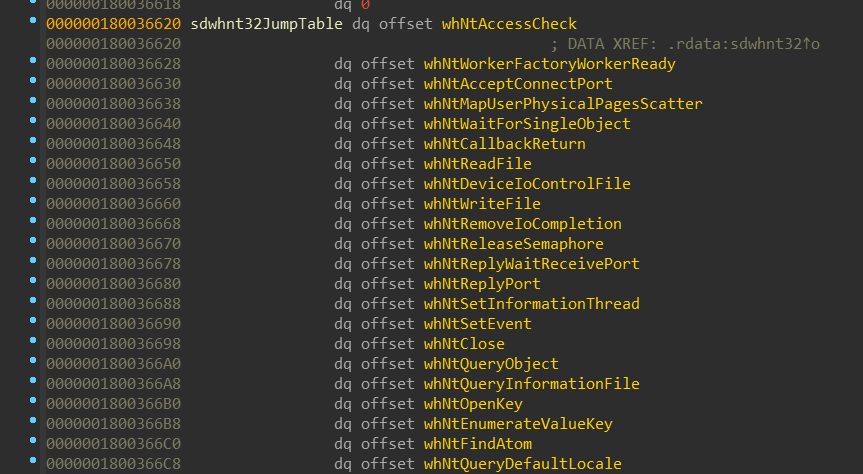
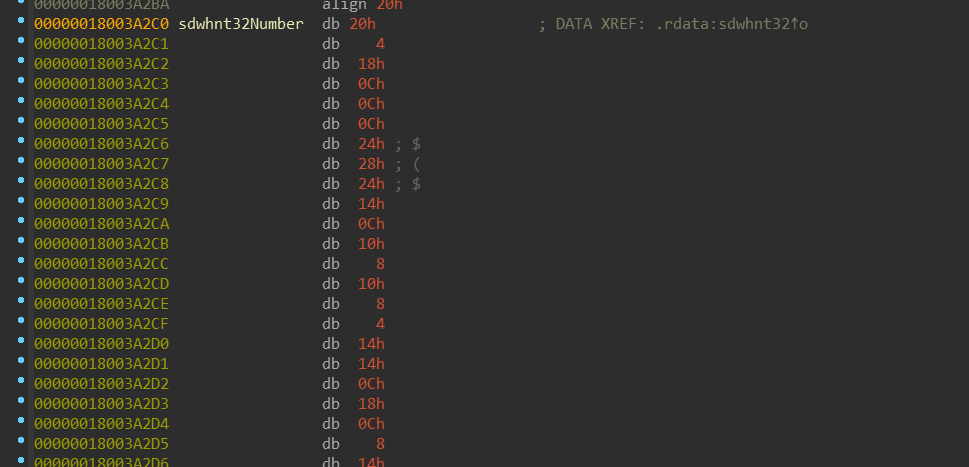
There is nothing surprising for those who already dealt with service tables in ntoskrnl.exe.
sdwhnt32JumpTable contains array of the system call functions, which are
traditionaly prefixed. WoW64 “system calls” are prefixed with wh*, which
honestly I don’t have any idea what it stands for - although it might be the
case as with Zw* prefix - it stands for nothing and is simply used as an
unique distinguisher.
The job of these wh* functions is to correctly convert any arguments and
return values from the 32-bit version to the native, 64-bit version. Keep in
mind that that it not only includes conversion of integers and pointers, but
also content of the structures. Interesting note might be that each of the
wh* functions has only one argument, which is pointer to an array of 32-bit
values. This array contains the parameters passed to the 32-bit system call.
As you could notice, in those 4 service tables there are “system calls” that
are not present in the ntoskrnl.exe. Also, I mentioned earlier that the
Wow64Transition is resolved in multiple DLLs. Currently, these DLLs export
this symbol:
ntdll.dllwin32u.dllkernel32.dllandkernelbase.dlluser32.dll
The ntdll.dll and win32u.dll are obvious and they represent the same thing
as their native counterparts. The service tables used by kernel32.dll and
user32.dll contain functions for transformation of particular csrss.exe calls
into their 64-bit version.
It’s also worth noting that at the end of the ntdll.dll system table, there
are several functions with NtWow64* calls, such as NtWow64ReadVirtualMemory64,
NtWow64WriteVirtualMemory64 and others. These are special functions which are
provided only to WoW64 processes.
One of these special functions is also NtWow64CallFunction64. It has it’s own
small dispatch table and callers can select which function should be called
based on its index:

NOTE: I’ll be talking about one of these functions - namely
Wow64CallFunctionTurboThunkControl- later in the Disabling Turbo thunks section.
wow64!Wow64SystemServiceEx
This function is similar to the kernel’s nt!KiSystemCall64 - it does the
dispatching of the system call. This function is exported by the wow64.dll
and imported by the emulation DLLs. Wow64SystemServiceEx accepts 2 arguments:
- The system call number
- Pointer to an array of 32-bit arguments passed to the system call (mentioned earlier)
The system call number isn’t just an index, but also contains index of a system
table which needs to be selected (this is also true for ntoskrnl.exe):
This function then selects ServiceTables[ServiceTableIndex] and calls the
appropriate wh* function based on the SystemCallNumber.
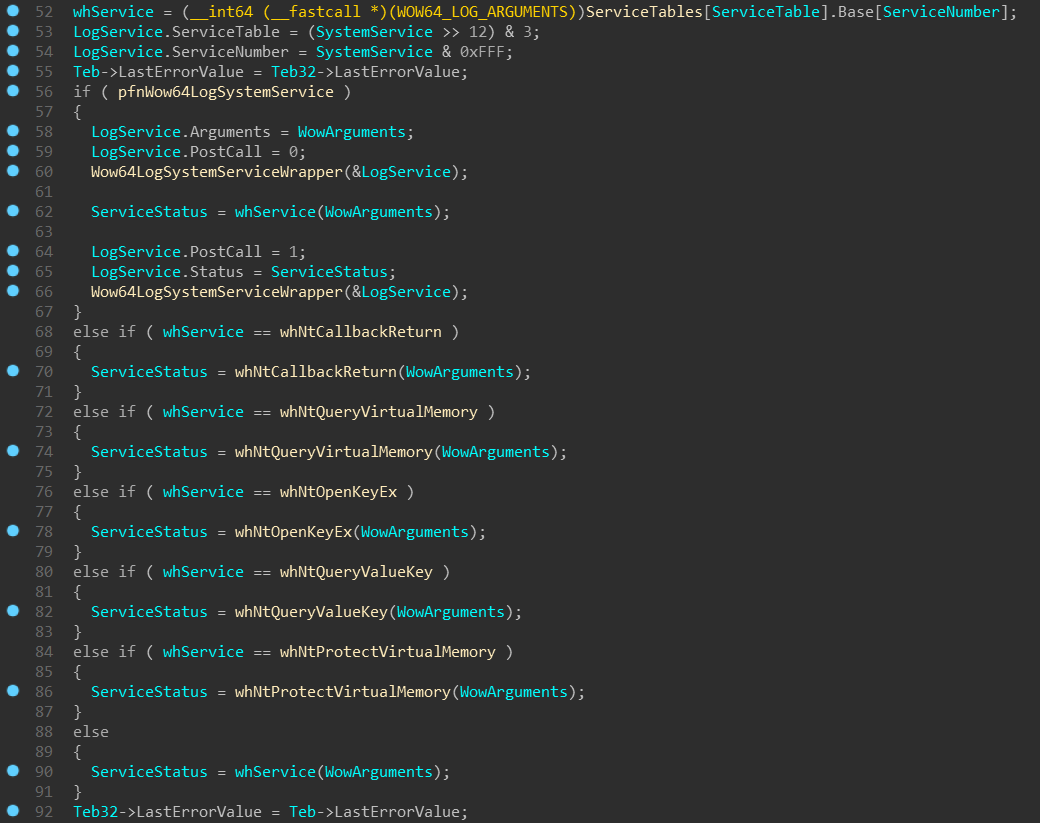
NOTE: In case the
wow64log.dllhas been successfully loaded, theWow64SystemServiceExfunction callsWow64LogSystemServiceWrapper(wrapper aroundwow64log!Wow64LogSystemServicefunction): once before the actual system call and one immediately after. This can be used for instrumentation of each WoW64 system call! The structure passed toWow64LogSystemServicecontains every important information about the system call - it’s table index, system call number, the argument list and on the second call, even the resultingNTSTATUS! You can find layout of this structure in the appendix (WOW64_LOG_SERVICE).
Finally, as have been mentioned, the WOW64_SERVICE_TABLE_DESCRIPTOR structure
differs from KSERVICE_TABLE_DESCRIPTOR in that it contains ErrorCase table.
The code mentioned above is actually wrapped in a SEH __try/__except
block. If whService raise an exception, the __except block calls
Wow64HandleSystemServiceError function. The function looks if the corresponding
service table which raised the exception has non-NULL ErrorCase and if it does,
it selects the appropriate WOW64_ERROR_CASE for the system call. If the ErrorCase
is NULL, the values from ErrorCaseDefault are used. The NTSTATUS of the
exception is then transformed according to an algorithm which can be found in the appendix.
wow64!ProcessInit (cont.)
...wow64!CpuLoadBinaryTranslator // MachineTypewow64!CpuGetBinaryTranslatorPath // MachineTypentdll!NtOpenKey // "\Registry\Machine\Software\Microsoft\Wow64\"ntdll!NtQueryValueKey // "arm" / "x86"ntdll!RtlGetNtSystemRoot // "arm" / "x86"ntdll!RtlUnicodeStringPrintf // "%ws\system32\%ws"
As you’ve probably guessed, this function constructs path to the binary-translator DLL,
which is - on x64 - known as wow64cpu.dll. This DLL will be responsible for
the actual low-level emulation.



We can see that there is no wow64cpu.dll on ARM64. Instead, there is xtajit.dll
used for x86 emulation and wowarmhw.dll used for ARM32 emulation.
NOTE: The
CpuGetBinaryTranslatorPathfunction is same on both x64 and ARM64 except for one peculiar difference: on Windows x64, if the\Registry\Machine\Software\Microsoft\Wow64\x86key cannot be opened (is missing/was deleted), the function contains a fallback to loadwow64cpu.dll. On Windows ARM64, though, it doesn’t have such fallback and if the registry key is missing, the function fails and the WoW64 process is terminated.
wow64.dll then loads one of the selected DLL and tries to find there following
exported functions:
BTCpuProcessInit (!) |
BTCpuProcessTerm |
BTCpuThreadInit |
BTCpuThreadTerm |
BTCpuSimulate (!) |
BTCpuResetFloatingPoint |
BTCpuResetToConsistentState |
BTCpuNotifyDllLoad |
BTCpuNotifyDllUnload |
BTCpuPrepareForDebuggerAttach |
BTCpuNotifyBeforeFork |
BTCpuNotifyAfterFork |
BTCpuNotifyAffinityChange |
BTCpuSuspendLocalThread |
BTCpuIsProcessorFeaturePresent |
BTCpuGetBopCode (!) |
BTCpuGetContext |
BTCpuSetContext |
BTCpuTurboThunkControl |
BTCpuNotifyMemoryAlloc |
BTCpuNotifyMemoryFree |
BTCpuNotifyMemoryProtect |
BTCpuFlushInstructionCache2 |
BTCpuNotifyMapViewOfSection |
BTCpuNotifyUnmapViewOfSection |
BTCpuUpdateProcessorInformation |
BTCpuNotifyReadFile |
BTCpuCfgDispatchControl |
BTCpuUseChpeFile |
BTCpuOptimizeChpeImportThunks |
BTCpuNotifyProcessExecuteFlagsChange |
BTCpuProcessDebugEvent |
BTCpuFlushInstructionCacheHeavy |
Interestingly, not all functions need to be found - only those marked with the
“(!)”, the rest is optional. As a next step, the resolved BTCpuProcessInit
function is called, which performs binary-translator-specific process initialization.
At the end of the ProcessInit function, wow64!Wow64ProtectMrdata(1) is called,
making .mrdata non-writable again.
wow64!ThreadInit
wow64!ThreadInitwow64!CpuThreadInitNtCurrentTeb32()->WOW32Reserved = BTCpuGetBopCode()emu!BTCpuThreadInit
ThreadInit does some little thread-specific initialization, such as:
- Copying
CurrentLocaleandIdealProcessorvalues from 64-bitTEBinto 32-bitTEB. - For non-
WOW64_CPUFLAGS_SOFTWAREemulators, it callsCpuThreadInit, which:- Performs
NtCurrentTeb32()->WOW32Reserved = BTCpuGetBopCode(). - Calls
emu!BTCpuThreadInit().
- Performs
- For
WOW64_CPUFLAGS_SOFTWAREemulators, it creates an event, which added intoAlertByThreadIdEventHashTableand set toNtCurrentTeb()->TlsSlots[18]. This event is used for special emulation ofNtAlertThreadByThreadIdandNtWaitForAlertByThreadId.
NOTE: The
WOW64_CPUFLAGS_MSFT64 (1)or theWOW64_CPUFLAGS_SOFTWARE (2)flag is stored in theNtCurrentTeb()->TlsSlots[/* 10 */ WOW64_TLS_WOW64INFO], in theWOW64INFO.CpuFlagsfield. One of these flags is always set in the emulator’sBTCpuProcessInitfunction (mentioned in the section above):
wow64cpu.dllsetsWOW64_CPUFLAGS_MSFT64 (1)wowarmhw.dllsetsWOW64_CPUFLAGS_MSFT64 (1)xtajit.dllsetsWOW64_CPUFLAGS_SOFTWARE (2)
x86 on x64
Entering 32-bit mode
...wow64!RunCpuSimulationwow64cpu!BTCpuSimulatewow64cpu!RunSimulatedCode
RunSimulatedCode runs in a loop and performs transitions into 32-bit mode
either via:
jmp fword ptr[reg]- a “far jump” that not only changes instruction pointer (RIP), but also the code segment register (CS). This segment usually being set to0x23, while 64-bit code segment is0x33- synthetic “machine frame” and
iret- called on every “state reset”
NOTE: Explanation of segmentation and “why does it work just by changing a segment register” is beyond scope of this article. If you’d like to know more about “long mode” and segmentation, you can start here.
Far jump is used most of the time for the transition, mainly because it’s faster.
iret on the other hand is more powerful, as it can change CS, SS, EFLAGS, RSP and RIP
all at once. The “state reset” occurs when WOW64_CPURESERVED.Flags has
WOW64_CPURESERVED_FLAG_RESET_STATE (1) bit set. This happens during exception
(see wow64!Wow64PrepareForException and wow64cpu!BTCpuResetToConsistentState).
Also, this flag is cleared on every emulation loop (using btr - bit-test-and-reset).
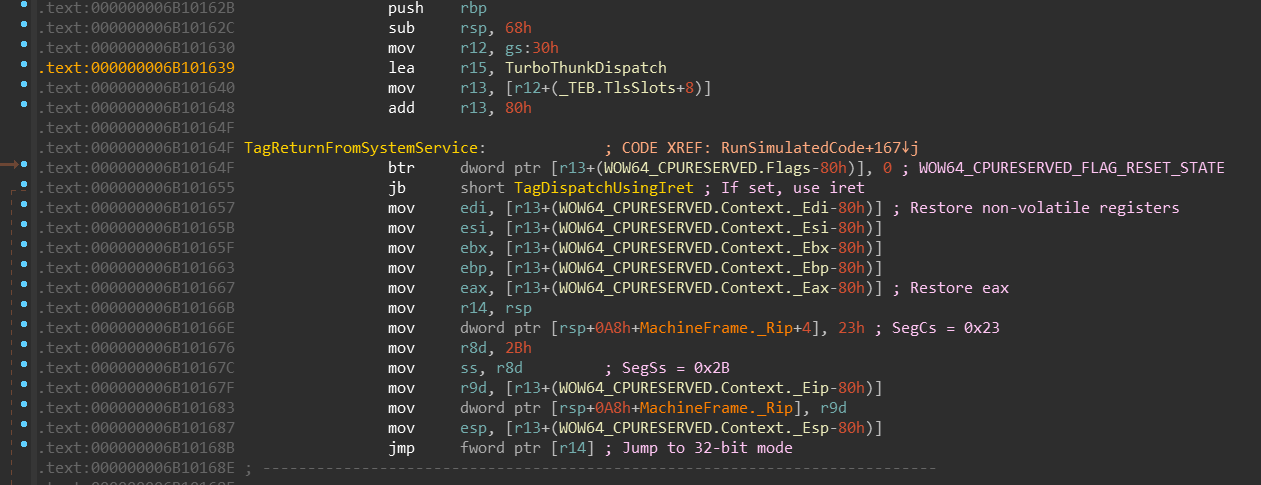
You can see the simplest form of switching into the 32-bit mode. Also, at the beginning
you can see that TurboThunkDispatch address is moved into the r15 register.
This register stays untouched during the whole RunSimulatedCode function.
Leaving 32-bit mode
The switch back to the 64-bit mode is very similar - it also uses far jumps. The usual situation when code wants to switch back to the 64-bit mode is upon system call:

The Wow64SystemServiceCall is just a simple jump to the Wow64Transition:

If you remember, the Wow64Transition value is resolved by the wow64cpu!BTCpuGetBopCode
function:

It selects either KiFastSystemCall or KiFastSystemCall2 based on the CpupSystemCallFast
value.
The KiFastSystemCall looks like this (used when CpupSystemCallFast != 0):
[x86] jmp 33h:$+9(jumps to the instruction below)[x64] jmp qword ptr [r15+offset](which points toCpupReturnFromSimulatedCode)
The KiFastSystemCall2 looks like this (used when CpupSystemCallFast == 0):
[x86] push 0x33[x86] push eax[x86] call $+5[x86] pop eax[x86] add eax, 12[x86] xchg eax, dword ptr [esp][x86] jmp fword ptr [esp](jumps to the instruction below)[x64] add rsp, 8[x64] jmp wow64cpu!CpupReturnFromSimulatedCode
Clearly, the KiFastSystemCall is faster, so why it’s not used used every time?
It turns out, CpupSystemCallFast is set to 1 in the wow64cpu!BTCpuProcessInit function if
the process is not executed with the ProhibitDynamicCode mitigation policy
and if NtProtectVirtualMemory(&KiFastSystemCall, PAGE_READ_EXECUTE) succeeds.
This is because KiFastSystemCall is in a non-executable read-only section (W64SVC) while
KiFastSystemCall2 is in read-executable section (WOW64SVC).
But the actual reason why is KiFastSystemCall in non-executable section by default and needs to be
set as executable manually is, honestly, unknown to me. My guess would be that
it has something to do with relocations, because the address in the jmp 33h:$+9
instruction must be somehow resolved by the loader. But maybe I’m wrong. Let me know if you know the answer!
Turbo thunks
I hope you didn’t forget about the TurboThunkDispatch address hanging in the
r15 register. This value is used as a jump-table:
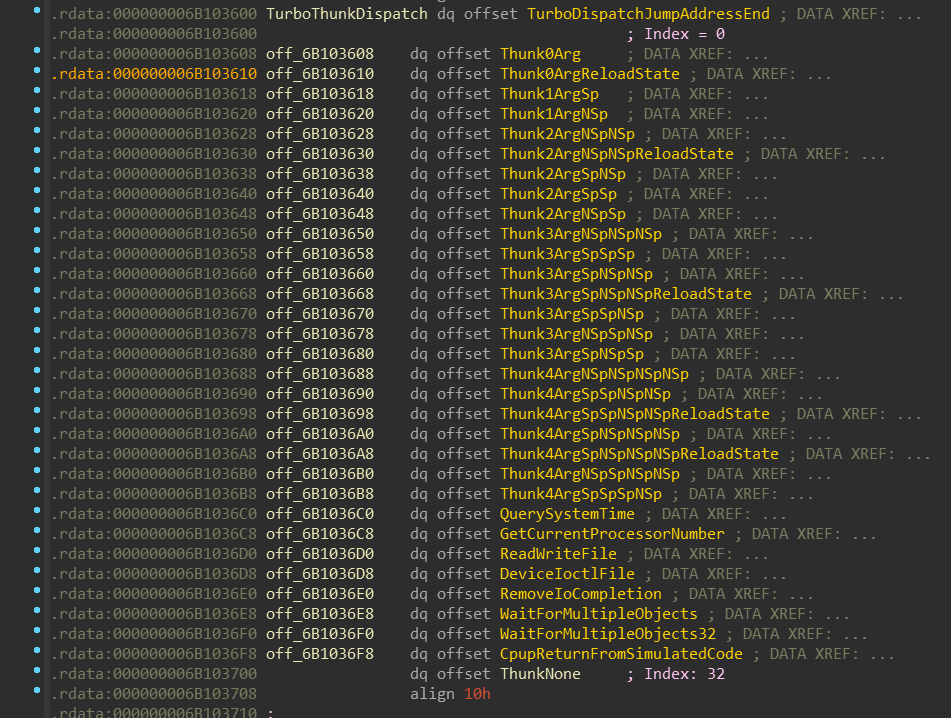
There are 32 items in the jump-table.
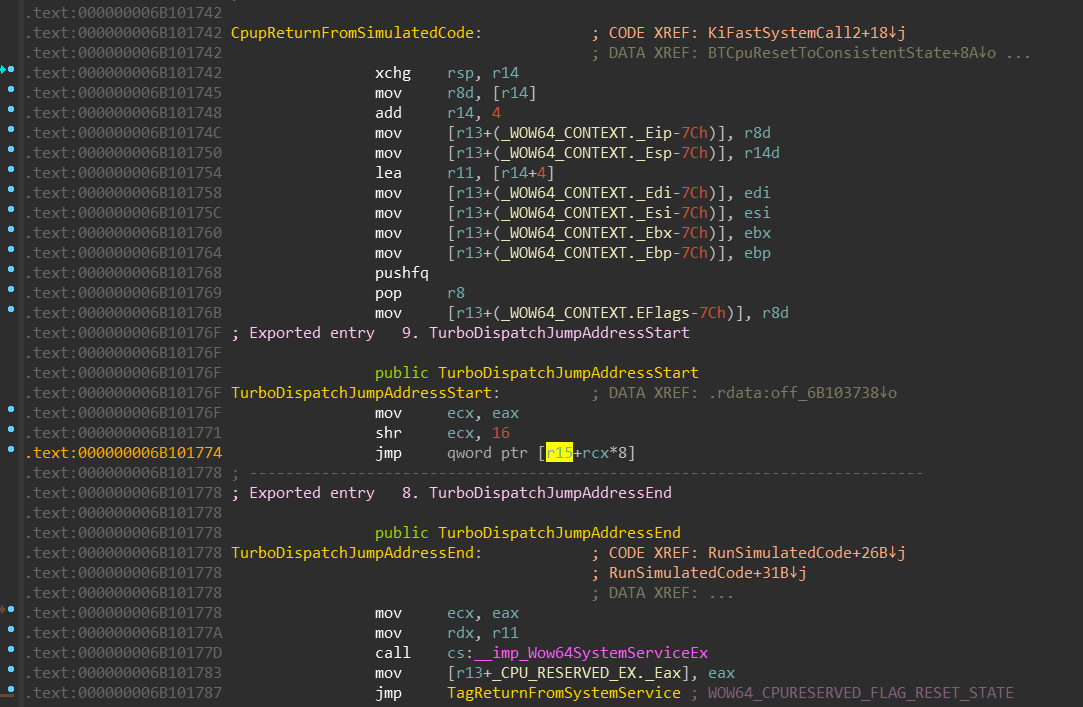
CpupReturnFromSimulatedCode is the first code that is always executed in the 64-bit
mode when 32-bit to 64-bit transition occurs. Let’s recapitulate the code:
- Stack is swapped,
- Non-volatile registers are saved
eax- which contains the encoded service table index and system call number - is moved into theecx- it’s high-word is acquired via
ecx >> 16. - the result is used as an index into the
TurboThunkDispatchjump-table
You might be confused now, because few sections above we’ve defined the service number like this:
…therefore, after right-shifting this value by 16 bits we should get always 0, right?
It turns out, on x64, the WOW64_SYSTEM_SERVICE might be defined like this:
Let’s examine few WoW64 system calls:



Based on our new definition of WOW64_SYSTEM_SERVICE, we can conclude that:
NtMapViewOfSectionuses turbo thunk with index 0 (TurboDispatchJumpAddressEnd)NtWaitForSingleObjectuses turbo thunk with index 13 (Thunk3ArgSpNSpNSpReloadState)NtDeviceIoControlFileuses turbo thunk with index 27 (DeviceIoctlFile)
Let’s finally explain “turbo thunks” in proper way.
Turbo thunks are an optimalization of WoW64 subsystem - specifically on Windows x64 -
that enables for particular system calls to never leave the wow64cpu.dll - the
conversion of parameters and return value, and the syscall instruction itself
is fully performed there. The set of functions that use these turbo thunks reveals,
that they are usually very simple in terms of parameter conversion - they receive
numerical values or handles.
The notation of Thunk* labels is as follows:
- The number specifies how many arguments the function receives
Spconverts parameter with sign-extensionNSpconverts parameter without sign-extensionReloadStatewill return to the 32-bit mode usingiretinstead of far jump, ifWOW64_CPURESERVED_FLAG_RESET_STATEis setQuerySystemTime,ReadWriteFile,DeviceIoctlFile, … are special cases
Let’s take the NtWaitForSingleObject and its turbo thunk Thunk3ArgSpNSpNSpReloadState
as an example:
- it receives 3 parameters
- 1st parameter is sign-extended
- 2nd parameter isn’t sign-extended
- 3rd parameter isn’t sign-extended
- it can switch to 32-bit mode using
iretifWOW64_CPURESERVED_FLAG_RESET_STATEis set
When we cross-check this information with its function prototype, it makes sense:
The sign-extension of HANDLE makes sense, because if we pass there an INVALID_HANDLE_VALUE,
which happens to be 0xFFFFFFFF (-1) on 32-bits, we don’t want to convert this value
to 0x00000000FFFFFFFF, but 0xFFFFFFFFFFFFFFFF.
On the other hand, if the TurboThunkNumber is 0, the call will end up in the
TurboDispatchJumpAddressEnd which in turn calls wow64!Wow64SystemServiceEx.
You can consider this case as the “slow path”.
Disabling Turbo thunks
On Windows x64, the Turbo thunk optimization can be actually disabled!
In one of
the previous sections I’ve been talking about ntdll32!NtWow64CallFunction64 and
wow64!Wow64CallFunctionTurboThunkControl functions. As with any other NtWow64*
function, NtWow64CallFunction64 is only available in the WoW64 ntdll.dll.
This function can be called with an index to WoW64 function in the
Wow64FunctionDispatch64 table (mentioned earlier).
The function prototype might look like this:
NOTE: This function prototype has been reconstructed with the help of the
wow64!Wow64CallFunction64Nopfunction code, which just logs the parameters.
We can see that wow64!Wow64CallFunctionTurboThunkControl can be called with an
index of 2. This function performs some sanity checks and then passes calls
wow64cpu!BTCpuTurboThunkControl(*(ULONG*)InputBuffer).
wow64cpu!BTCpuTurboThunkControl then checks the input parameter.
- If it’s 0, it patches every target of the jump table to point to
TurboDispatchJumpAddressEnd(remember, this is the target that is called whenWOW64_SYSTEM_SERVICE.TurboThunkNumberis 0). - If it’s non-0, it returns
STATUS_NOT_SUPPORTED.
This means 2 things:
- Calling
wow64cpu!BTCpuTurboThunkControl(0)disables the Turbo thunks, and every system call ends up taking the “slow path”. - It is not possible to enable them back.
With all this in mind, we can achieve disabling Turbo thunks by this call:
What it might be good for? I can think of 3 possible use-cases:
-
If we deploy custom
wow64log.dll, disabling Turbo thunks guarantees that we will see every WoW64 system call in ourwow64log!Wow64LogSystemServicecallback. We wouldn’t see such calls if the Turbo thunks were enabled, because they would take the “fast path” inside of thewow64cpu.dllwhere thesyscallwould be executed. -
If we decide to hook
Nt*functions in the nativentdll.dll, disabling Turbo thunks guarantees that for eachNt*function called in thentdll32.dll, the correspondintNt*function will be called in the nativentdll.dll. (This is basically the same point as the previous one.)NOTE: Keep in mind that this only applies on system calls, i.e. on
Nt*orZw*functions. Other functions are not called from the 32-bitntdll.dllto the 64-bitntdll.dll. For example, if we hookedRtlDecompressBufferin the nativentdll.dllof the WoW64 process, it wouldn’t be called onntdll32!RtlDecompressBuffercall. This is because the full implementaion of theRtl*functions is already in thentdll32.dll. -
We can “harmlessly” patch high-word moved to the
eaxin every WoW64 system call stub to 0. For example we could see inNtWaitForSingleObjectthere ismov eax, 0D0004h. If we patched appropriate 2 bytes in that instruction so that the instruction would becomemov eax, 4h, the system call would still work.This approach can be used as an anti-hooking technique - if there’s a jump at the start of the function, the patch will break it. If there’s not a jump, we just disable the Turbo thunk for this function.
x86 on ARM64
Emulation of x86 applications on ARM64 is handled by an actual binary translation.
Instead of wow64cpu.dll, the xtajit.dll (probably shortcut for “x86 to ARM64 JIT”)
is used for its emulation. As with other emulation DLLs, this DLL is native (ARM64).
The x86 emulation on Windows ARM64 consists also of other “XTA” components:
xtac.exe- XTA CompilerXtaCache.exe- XTA Cache Service
Execution of x86 programs on ARM64 appears to go way behind just emulation. It
is also capable of caching already binary-translated code, so that next execution
of the same application should be faster. This cache is located in the Windows\XtaCache
directory which contains files in format FILENAME.EXT.HASH1.HASH2.mp.N.jc.
These files are then mapped to the user-mode address space of the application.
If you’re asking whether you can find an actual ARM64 code in these files - indeed,
you can.
Unfortunatelly, Microsoft doesn’t provide symbols to any of these xta* DLLs or executables. But if
you’re feeling adventurous, you can find some interesting artifacts, like
this array of structures inside of the xtajit.dll, which contains name of the function and its pointer.
There are thousands of items in this array:
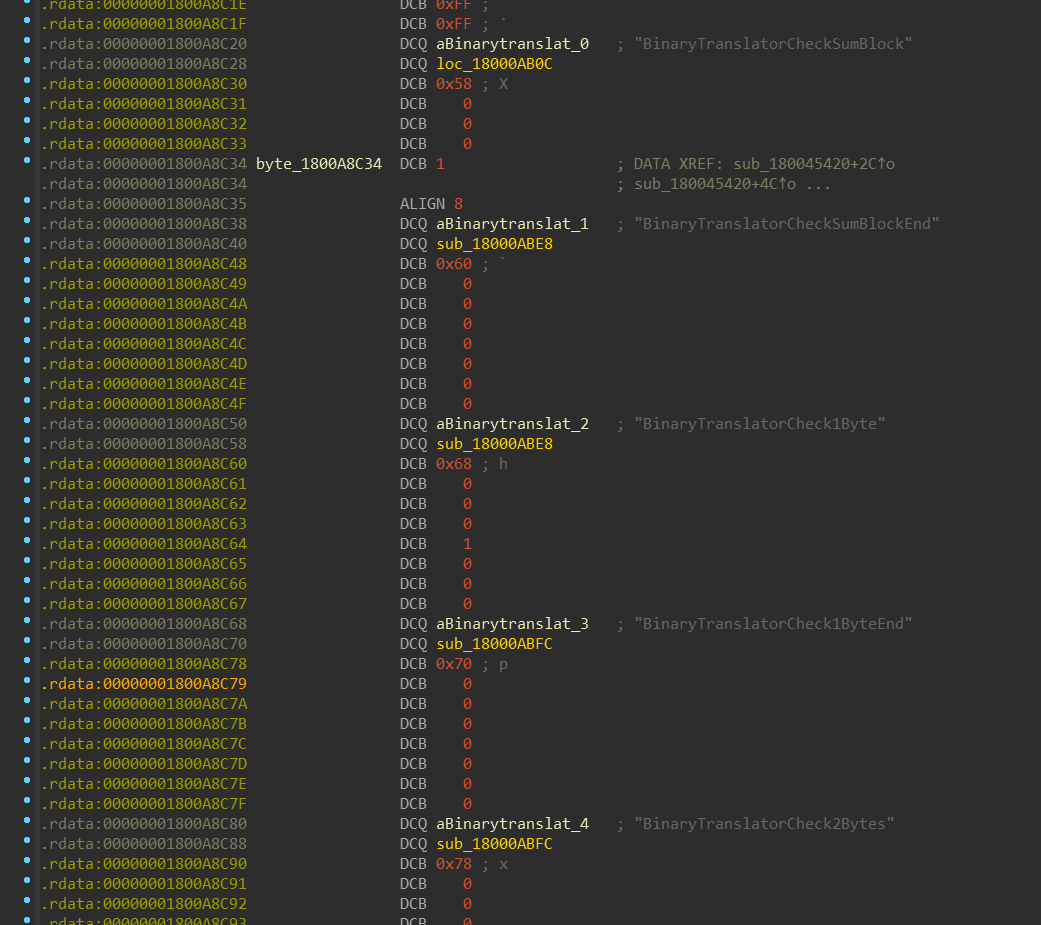
With a simple Python script, we can mass-rename all functions referenced in this array:
I’d like to thank Milan Boháček for providing me this script.
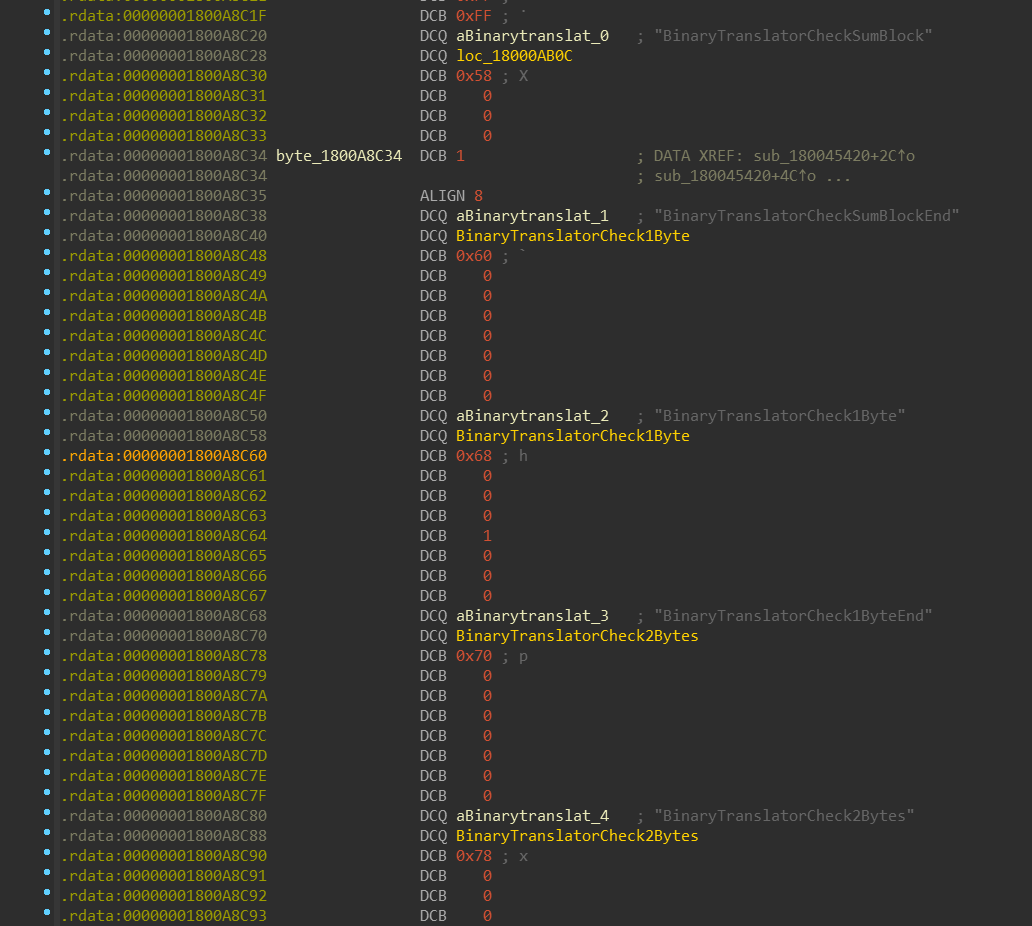
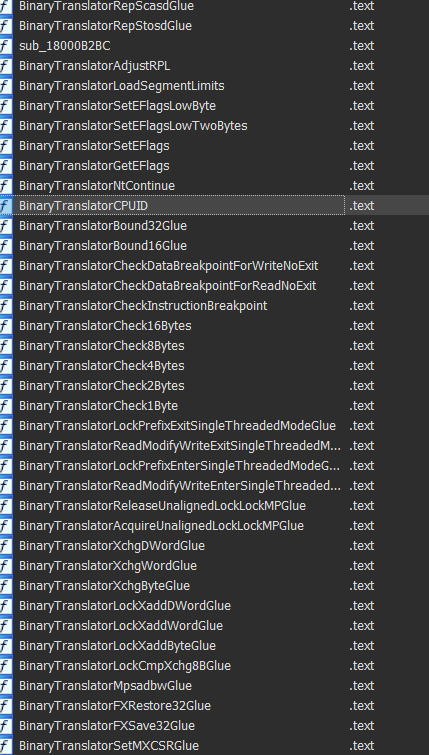
Windows\SyCHPE32 & Windows\SysWOW64
One thing you can observe on ARM64 is that it contains two folders used for x86
emulation. The difference between them is that SyCHPE32 contains small subset
of DLLs that are frequently used by applications, while contents of the SysWOW64
folder is quite identical with the content of this folder on Windows x64.
The CHPE DLLs are not pure-x86 DLLs and not even pure-ARM64 DLLs. They are
“compiled-hybrid-PE”s. What does it mean? Let’s see:
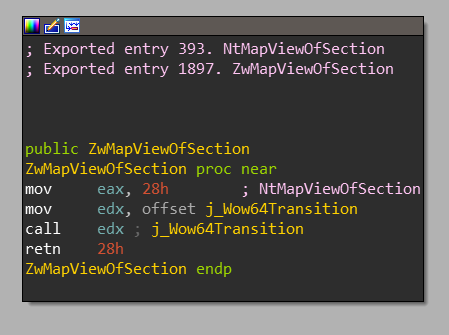
After opening SyCHPE32\ntdll.dll, IDA will first tell us - unsurprisingly -
that it cannot download PDB for this DLL. After looking at randomly chosen Nt*
function, we can see that it doesn’t differ from what we would see in the
SysWOW64\ntdll.dll. Let’s look at some non-Nt* function:
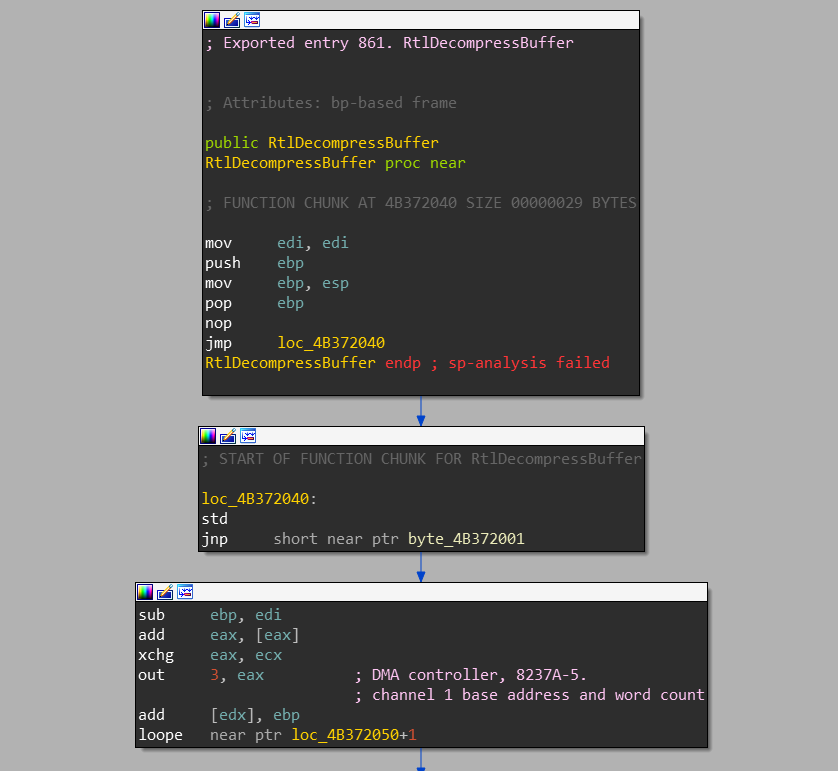
We can see it contains regular x86 function prologue, immediately followed by x86 function epilogue and then jump somewhere, where it looks like that there’s just garbage. That “garbage” is actually ARM64 code of that function.
My guess is that the reason for this prologue is probably compatibility with applications that check whether some particular functions are hooked or not - by checking if the first bytes of the function contain real x86 prologue.
NOTE: Again, if you’re feeling adventurous, you can patch
FileHeader.Machinefield in the PE header toIMAGE_FILE_MACHINE_ARM64 (0xAA64)and open this file in IDA. You will see a whole lot of correctly resolved ARM64 functions. Again, I’d like to thank to Milan Boháček for this tip.
If your question is “how are these images generated?”, I would answer that I don’t know,
but my bet would be on some internal version of Microsoft’s C++ compiler toolchain. This idea
appears to be supported by various occurences of the CHPE keyword in the ChakraCore codebase.
ARM32 on ARM64
The loop inside of the wowarmhw!BTCpuSimulate is fairly simple compared to
wow64cpu.dll loop:
CpupSwitchTo32Bit does nothing else than saving the whole CONTEXT, performing SVC 0xFFFF
instruction and then restoring the CONTEXT.
nt!KiEnter32BitMode / SVC 0xFFFF
I won’t be explaining here how system call dispatching works in the ntoskrnl.exe -
Bruce Dang already did an excellent job doing it.
This section is a follow up on his article, though.
SVC instruction is sort-of equivalent of SYSCALL instruction on ARM64 - it
basically enters the kernel mode. But there is a small difference between SYSCALL
and SVC: while on Windows x64 the system call number is moved into
the eax register, on ARM64 the system call number can be encoded directly
into the SVC instruction.
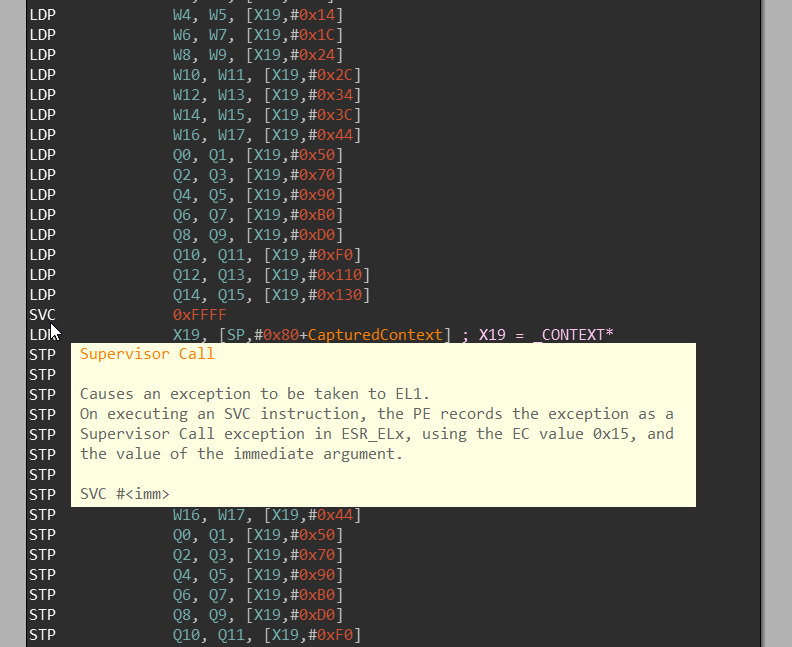
Let’s peek for a moment into the kernel to see how is this SVC instruction handled:
nt!KiUserExceptionHandlernt!KiEnter32BitMode
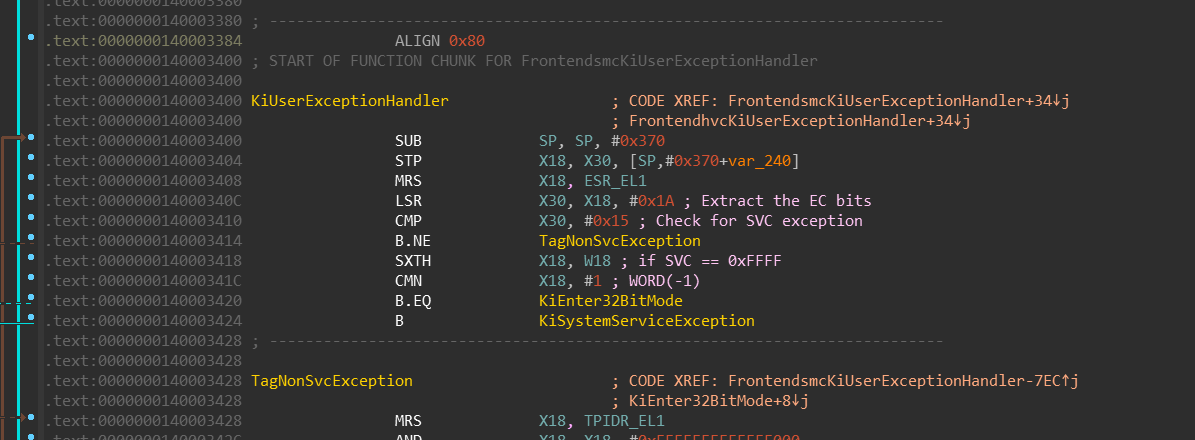
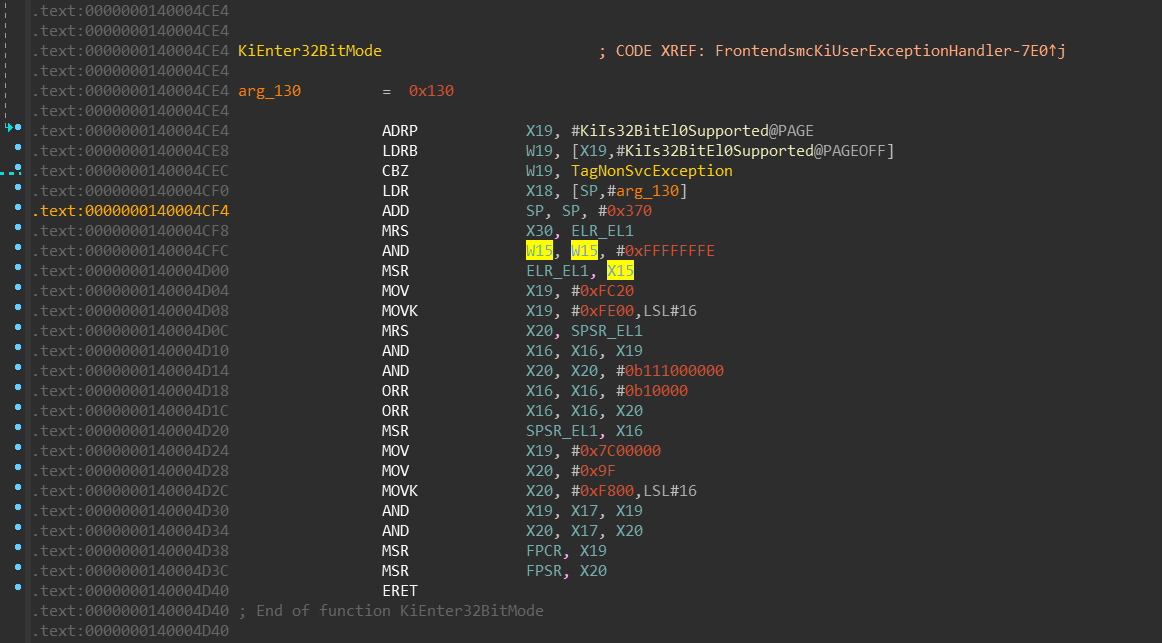
We can see that:
MRS X30, ELR_EL1- current interrupt-return address (stored inELR_EL1system register) will be moved to the registerX30(link register -LR).MSR ELR_EL1, X15- the interrupt-return address will be replaced by value in the registerX15(which is aliased to the instruction pointer register -PC- in the 32-bit mode).ORR X16, X16, #0b10000- bit [4] is being set inX16which is later moved to theSPSR_EL1register. Setting this bit switches the execution mode to 32-bits.
Simply said, in the X15 register, there is an address that will be
executed once we leave the kernel-mode and enter the user-mode - which happens
with the ERET instruction at the end.
nt!KiExit32BitMode / UND #0xF8
Alright, we’re in the 32-bit ARM mode now, how exactly do we leave? Windows
solves this transition via UND instruction - which is similar to the UD2
instruction on the Intel CPUs. If you’re not familiar with it, you just
need to know that it is instruction that basically guarantees that it’ll
throw “invalid instruction” exception which can OS kernel handle. It is defined-“undefined instruction”.
Again there is the same difference between the UND and UD2 instruction in
that the ARM can have any 1-byte immediate value encoded directly in the
instruction.
Let’s look at the NtMapViewOfSection system call in the SysArm32\ntdll.dll:

Let’s peek into the kernel again:
nt!KiUser32ExceptionHandlernt!KiFetchOpcodeAndEmulatent!KiExit32BitMode

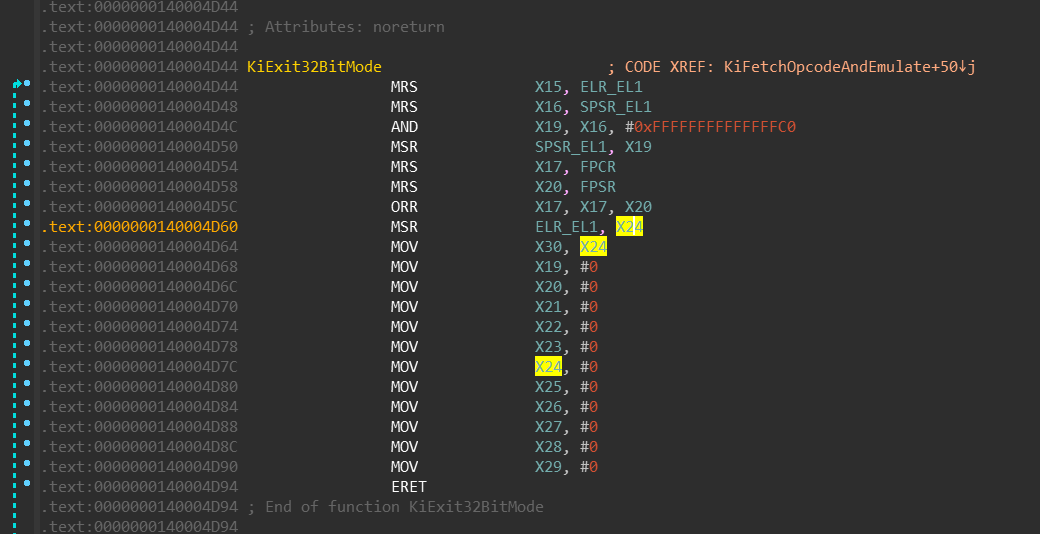
Keep in mind that meanwhile the 32-bit code is running, it cannot modify the value of the
previously stored X30 register - it is not visible in 32-bit mode. It stays there the
whole time. Upon UND #0xF8 execution, following happens:
- the
KiFetchOpcodeAndEmulatefunction moves value ofX30intoX24register (not shown on the screenshot). AND X19, X16, #0xFFFFFFFFFFFFFFC0- bit [4] (among others) is being cleared in theX19register, which is later moved to theSPSR_EL1register. Clearing this bit switches the execution mode back to 64-bits.KiExit32BitModethen moves the value ofX24register into theELR_EL1register. That means when this function finishes its execution, theERETbrings us back to the 64bit code, right after theSVC 0xFFFFinstruction.
NOTE: It can be noticed that Windows uses
UNDinstruction for several purposes. Common example might also beUND #0xFEwhich is used as a breakpoint instruction (equivalent of__debugbreak()/int3)
As you could spot, 3 kernel transitions are required for emulation of the
system call (SVC 0xFFFF, system call itself, UND 0xF8). This is because on
ARM there doesn’t exist a way how to switch between 32-bit and 64-bit mode only
in user-mode.
If you’re looking for “ARM Heaven’s Gate” - this is it. Put whatever function
address you like into the X15 register and execute SVC 0xFFFF.
Next instruction will be executed in the 32-bit ARM mode, starting with that
address. When you feel you’d like to come back into 64-bit mode, simply
execute UND #0xF8 and your execution will continue with the next instruction
after the SVC 0xFFFF.
Appendix
References
How does one retrieve the 32-bit context of a Wow64 program from a 64-bit process on Windows Server 2003 x64?
http://www.nynaeve.net/?p=191
Mixing x86 with x64 code
http://blog.rewolf.pl/blog/?p=102
Windows 10 on ARM
https://channel9.msdn.com/Events/Build/2017/P4171
Knockin’ on Heaven’s Gate – Dynamic Processor Mode Switching
http://rce.co/knockin-on-heavens-gate-dynamic-processor-mode-switching/
Closing “Heaven’s Gate”
http://www.alex-ionescu.com/?p=300